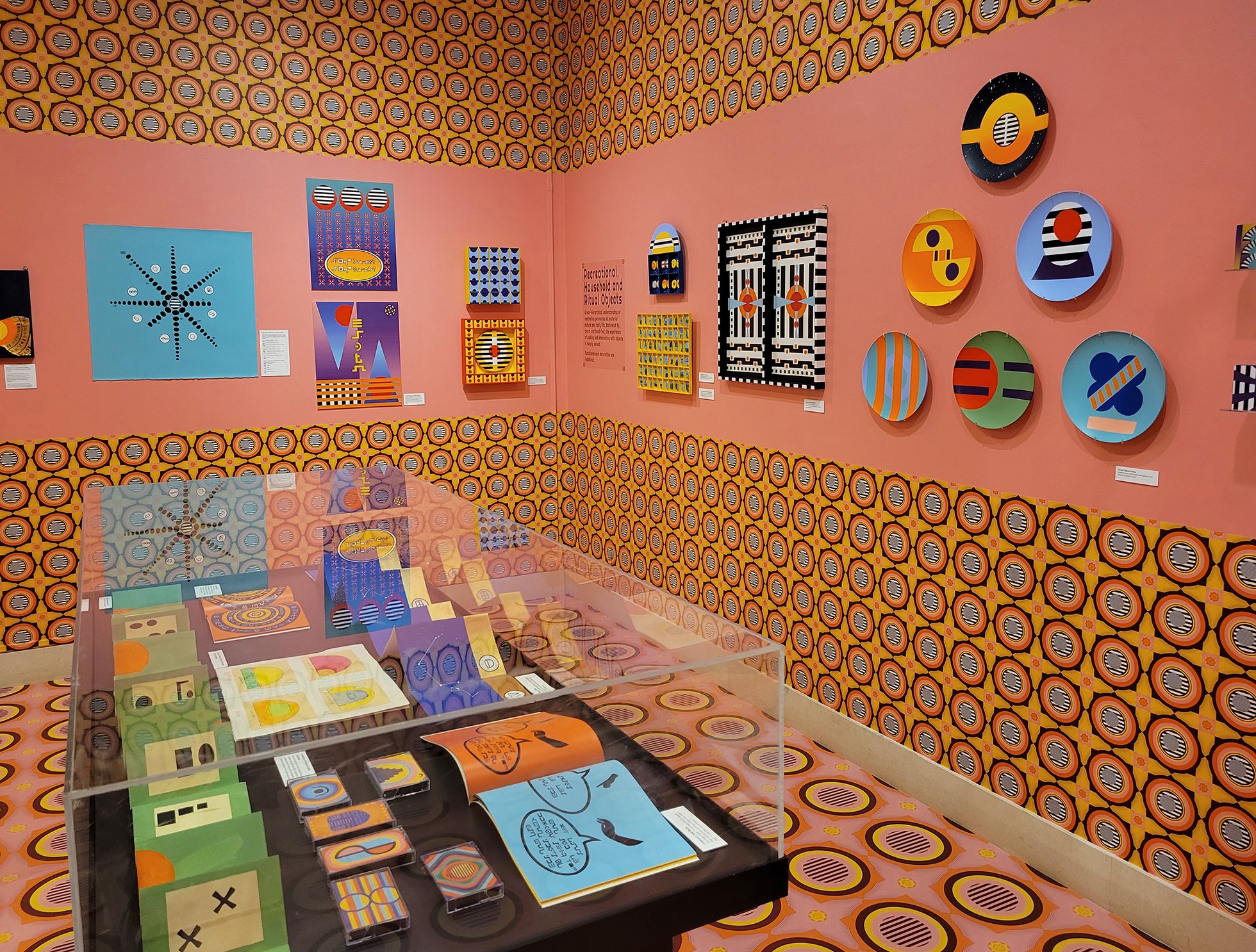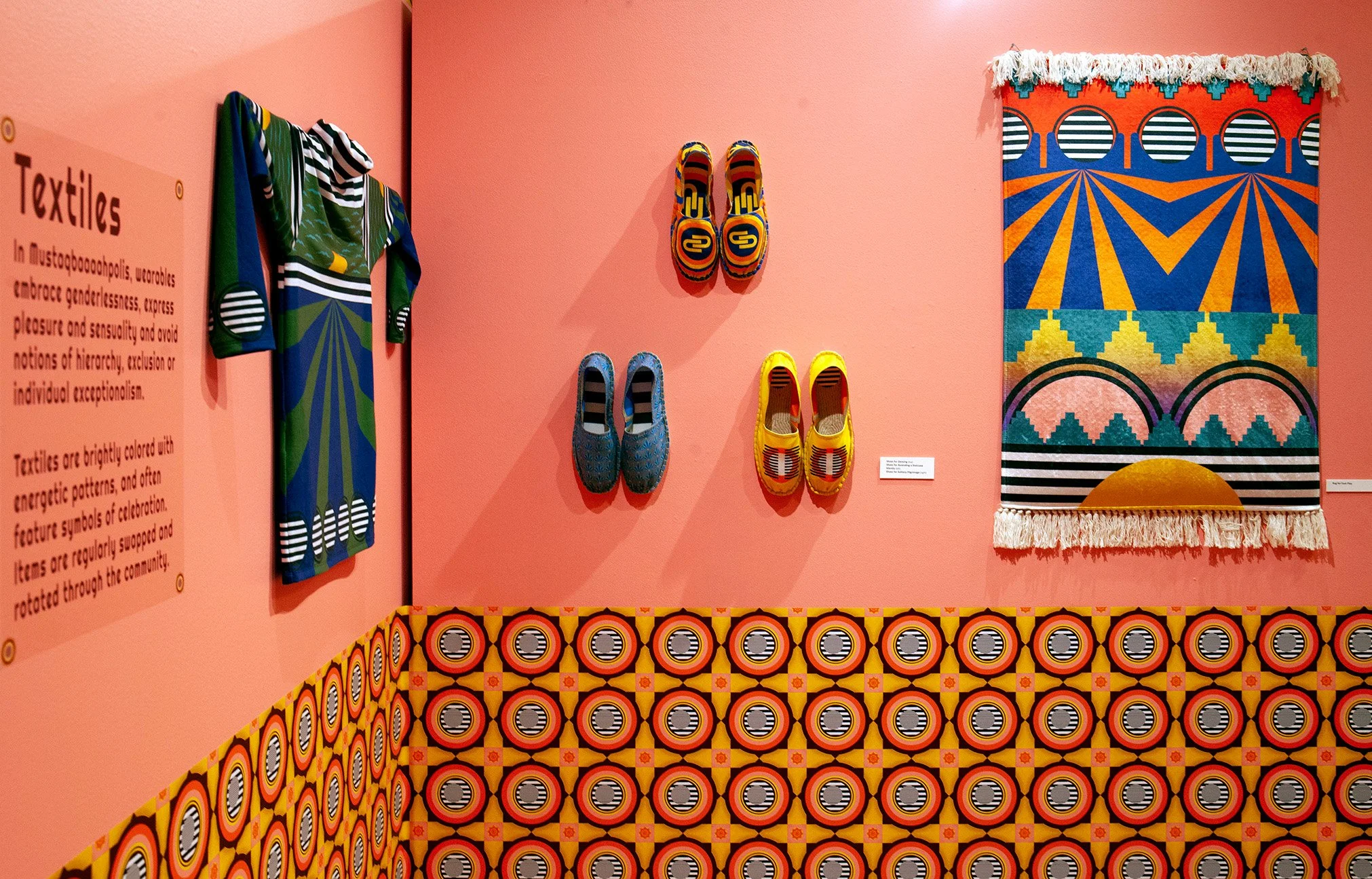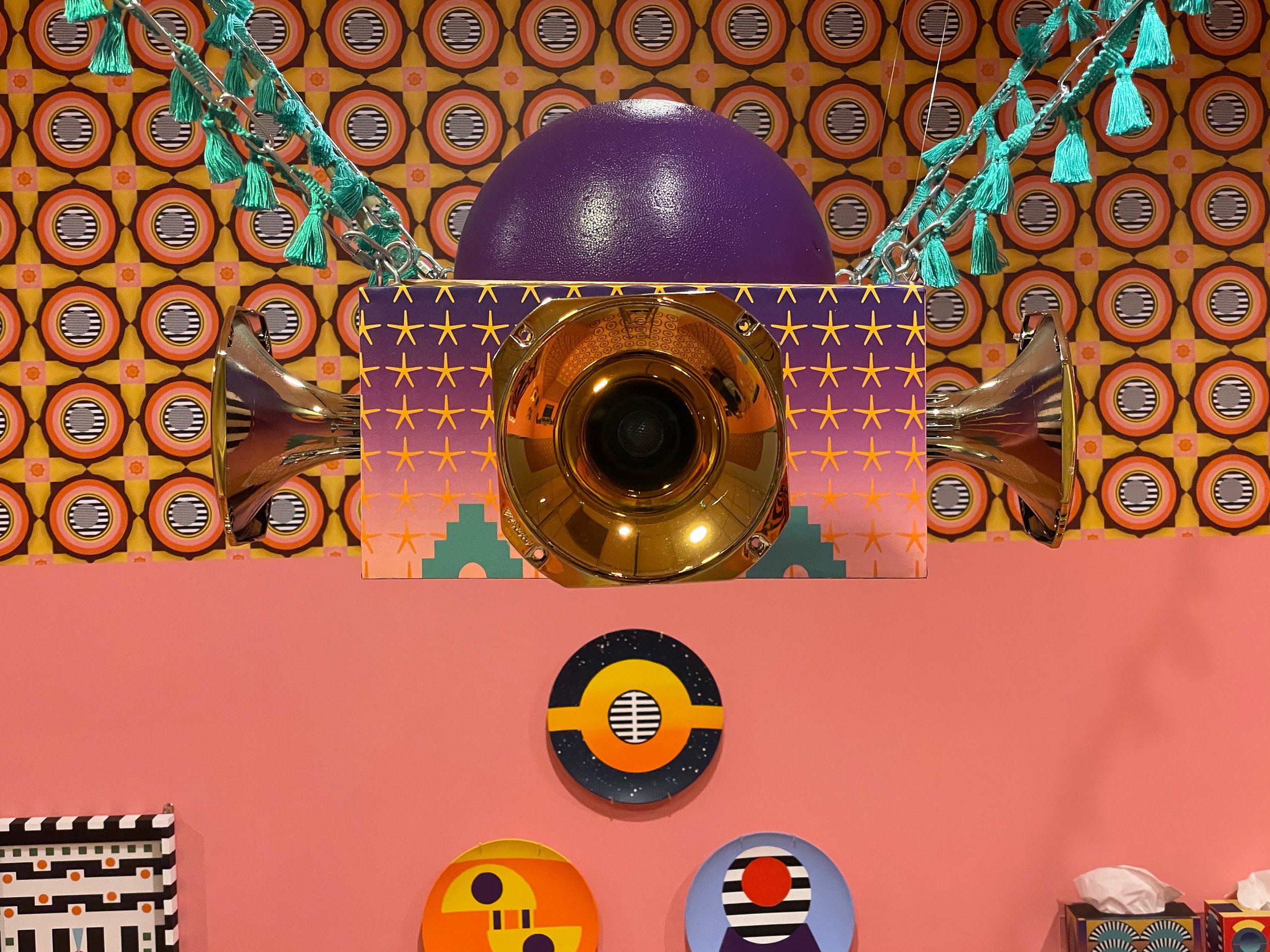Example #1) Souvenirs from the Future (2022)
Collaborative project created with Dahlia Elsayed, installation at The Arab American National Museum
Souvenirs from the Future is a fictive survey of artifacts from an undated future that tell the story of Mustaqbaaaahpolis (future-breath-city), a city built on interchange of ideas, aesthetics and knowledge in a system liberated of chrononormativity and extractive economic systems. The exhibition presents the material culture and rituals of this thriving south west Asian / north African (SWANA) imaginary, which values sensory experiences, creativity, post-commodity exchanges and a deep connection to the environmental cycles. It is a fictive ethnographic museum inside an ethnographic museum.
In my artwork, I build linguistic, sonic and visual environments that disrupt habituated ways of reading, hearing and seeing. My interdisciplinary practice examines structures that shape consciousness and perception, questioning frameworks that support the status quo and limit thought. The works are often presented in non-traditional spaces and take the form of multimodal installations, generative artworks, video poems, augmented reality apps and live performances.
Example #2) Souvenirs from the Future (2022)
Collaborative project created with Dahlia Elsayed, installation at The Arab American National Museum
Souvenirs from the Future uses the familiar experience of engaging with traditional institutional presentations that look back in linear time, but here we invite visitors to look forward and envision the possibilities of a future history. The story of Mustaqbaaaahpolis is told through wall text and artifact labels. The installation is divided into five sections, the Textiles section is pictured below.
The Wall text on the left reads:“In Mustaqbaaaahpolis, wearables embrace genderlessness, express pleasure and sensuality. Textiles are brightly colored with energetic patterns, and often feature symbols of celebration. Apparel intentionally does not feed notions of hierarchy, superiority, exclusion or individual exceptionalism, and items are regularly swapped and rotated through the community.”
The Wall label text reads: “Shirt for Bird Watching” (left), “Shoes for Dancing”, “Shoes for Ascending a Staircase Silently”, “Shoes for Solitary Pilgrimage” (middle), “Rug for Foot Play” (right)
Example #3) Souvenirs from the Future (2022)
Collaborative project created with Dahlia Elsayed, installation at The Arab American National Museum
Detail of the Sound Lamp which hangs from the ceiling in the center of the installation. In Mustaqbaaaahpolis, the two-speaker stereo convention was replaced by 360º sound for circular spatial listening. The installation has a multi-channel soundtrack composed by the artists that plays throughout the day. The music features traditional SWANA instruments (ney, karoun, zurna, doumbek, etc..) mixed with strings like an Uum Kulthum recording, but stretched to an extreme duration to create a floating, ethereal sound.
Example #4) Which Yesterday is Tomorrow? (2020)
Collaborative project with Dahlia Elsayed, installation at Transformer Gallery, Washington, DC
This multi-sensory installation reimagines the Silk Road caravanserai as a potential site for the exchange of ideas and culture, it is a rest stop for the future based on the past. By drawing upon the vocabulary of social and sacred architecture from Southwest Asia and North Africa (SWANA), Elsayed and Demirjian – both diasporic artists from this region – create a space for engagement, pause, and reflection. The cushions, pillows, rugs, wallpaper, altar and speakers were all designed by the artists. All of the sculptures were created by the artists except for the left hand objects on white shelves, these were part of the artistic exchange between SWANA artists who contributed their work to this section of the piece.
Example #5) Which Yesterday is Tomorrow? (2020)
Collaborative project with Dahlia Elsayed, installation at Transformer Gallery, Washington, DC
Which Yesterday is Tomorrow? questions Western perceptions of time with an immersive environment intended to break down barriers between, past, present and future by reconnecting visitors with the senses, rituals, and mythologies that have been diminished in an age dominated by relentless commerce and time scarcity. The installation conjures a fictive location where aesthetics and ideologies are exchanged freely, establishing an alternative to the violence, crisis, and territoriality typically associated with the region’s portrayal in American media.
Example #6) Which Yesterday is Tomorrow? (2020)
Collaborative project with Dahlia Elsayed, installation at Transformer Gallery, Washington, DC
The ‘Poetry for Alpha Wave States’ section of the installation is an interactive sound piece that triggers poetry whispered into the listeners ears as they lie down on the rugs or lay prostrate. The artists, in collaboration with artist Sha Sha Feng, created a painted striped circular disc that triggers poetry when movement occurs near it. In line with the idea of creating a place for aesthetic dialog, Elsayed and Demirjian reached out to artists and writers from the SWANA region to contribute a poem by a South West Asia/North Africa poet that relates to themes in the exhibition. This section of the installation creates a novel corporeal aesthetic experience for the body, immersing the listener in the lush fabric of the rug, lowering the body to the floor to engage with poetic language.
Example #8) Echoes of Liberation (2020)
Echoes of Liberation is a commissioned sonic monument for Rutgers University Newark honoring members of the Black Organization of Students (BOS) who advocated for greater inclusivity in enrolling students and hiring professors during the late 1960’s. The piece is an audio Augmented Reality artwork, a free iOS application available in the Apple App store, co-created with graduate students from Rutgers University Newark and NJIT.
The audio consists of interviews with BOS members who were active during this period conducted in the fall of 1991 by Gilbert Cohen including Joseph Brown, Vickie Donaldson, Richard Roper, and Vivian Sanks-King. Echoes of Liberation is a collaborative project that thematically excerpts these interviews and spatially maps them to sections of the campus to allow visitors to hear the reflections of BOS members about the liberation of Conklin Hall, its planning and aftermath. The sustained actions of BOS members had a significant impact on the process of making Rutgers University Newark one of the most diverse campuses in the United States.
The audio plays automatically based on your location in Norman Samuels Plaza. There are four sections of audio that are thematically grouped and placed in different sites in the plaza. The pathway between Hill Hall and Paul Robeson Campus Center from Dr. Martin Luther King Jr. Blvd. into the plaza is the ‘infinitive verb alley’ consisting of the infinitive verbs that were used by BOS members to describe their actions and process. On the plaza side of Paul Robeson Campus Center (the name change of which was instigated by BOS members) is the ‘audio walk of fame’ section where BOS members recite the names of the members who took part in the liberation of Conklin Hall. The northeast section of Paul Robeson Campus Center with overhanging roof and outdoor seating is the ‘cantilever questions’ section. In this area, questions that BOS members asked themselves and each other are heard. Finally, in the fourth section of the plaza, ‘foundations and forking paths’, the listener hears BOS members discuss the books, authors, activists and philosophers who had an impact on their thinking. The interview excerpts were played into the architecture of the campus with radios and re-recorded so the listener hears the voices of BOS members echoing off the walls where they are standing. The video below plays excerpts from the ‘infinitive verb alley’ and the ‘cantilever questions’ sections.
Example #7) The Artist’s Way (2022)
Collaborative project with James Proctor, installation at the Lemmerman Gallery, New Jersey City University
The Artist’s Way is an audiovisual navigation through the language space of artist statements. The installation remixes over 400 artist statements of self-identified practitioners of digital/electronic arts practitioners to produce a generative three-dimensional poem, creating a linguistic hopscotch across the collective mind of digital artists. The Artist's Way consists of two large-scale projected artworks that draw upon the history of poetic structures to generate rules for parsing and sequencing the 16,000 words to form a new visual poem. By re-positioning the meta-language of artists' statements as the art itself, The Artist’s Way aims to create a space to contemplate the role that systems of language play in our engagement with art. The piece is concerned with the way words can foreclose possibilities, reduce critical thinking, limit engagement and diminish sensitivity to sensory perception when we engage with art.
Example #9) Audible Geology: Deep Time Soundscapes (2014)
Installation at the Visual Art Center, Summit, NJ
The raw materials for Audible Geology were recorded during a month-long artist residency through the National Park Service in the Grand Canyon. During the residency, autonomous field recorders were placed at various locations and elevations on the south rim creating a vast sonic database of hundreds of hours of audio. The project puts the diverse sound environments across the canyon center stage to enable the listener to experience the aural ecosystems at play at all hours of the day and night. The piece tries to recalibrate the overabundance of visual images of one of the most widely photographed American landscapes, with the rich, infrequently heard sonic world of the canyon.
This installation featured multiple interactive sound installations that focused on different themes or groupings from the recordings presented in different ways. In addition, a collection of audio postcards were produced that allowed users to hear different areas of the canyon. These postcards were placed alongside traditional postcards in one of the Grand Canyon’s gift shops during the duration of the exhibition.
The image to the left is the ‘sound shower’ section of the installation. It is an 8-channel audiovisual interactive piece. There are four speakers overhead and four at the waist, the listener steps into the center and chooses between 6 different ‘sound showers’. Each one has an accompanying visualization showing the path of the sound as it moves around the body.
For one of the pieces, the same thunderbolt is heard from three different height elevations in the canyon (the bottom, middle and near the top), this sound is cycled around the listener like a clock hand moving clockwise. The listener is put in a surreal sonic head space of hearing from multiple drastically different height elevations at the same time.
Example #10) Scenes From Last Week (2011)
Interactive installation / Public Artwork
In a city constantly moving forward and erasing its relationship with the past, Scenes from Last Week seeks to re-insert the past into the present. The work is a public art installation that uses video surveillance in storefront windows that show the current street view and the view from seven previous days synchronized to the present moment, enabling the passerby to see the immediate history of where they are standing. This work was created during an artist residency at Eyebeam Art and Technology Center in New York.
"This accessible and inventive work is an excellent example of the way in which the current generation of artists engage with the aesthetic and social implications of the technological potential of the video image and the continuing public fascination with the medium" - Christopher Meigh Andrews, A History of Video Art 2nd Edition (Bloomsbury Press)






